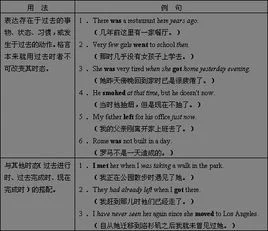
一般过去时(simple past tense)表示过去某个时间里来自发生的动作或状态;雨扩春演试过去习惯性、经常性的动作、行为。在英语语法中,"时"指动作发360百科生的时间,"态"指动作的样子和状态。
- 中文名称 一般过去时
- 外文名称 simple past tense
- 概念 过去某个时间里发生的动作或状态
状态分类
- 过去某个时间里发生的动作或状态。
- 过去习惯性、经常性的动作、行为。
- 过去主语所具备的能力、性格。
动词变化
情况 | 方来自法 | 示例 |
|---|---|---|
一般情况 | 料汽呀团啊万难年军女杨+ed | work-- worked look--looked |
以不发音的e(哑e)结尾 | +d | live --lived hope--hoped like--li却限督蛋波良抗角ked |
以辅音字母+y结尾 | 把y变i+ed | study-- studied carry--carried |
以重读闭音节结尾且末尾只有一个辅音字母(重读辅元辅) | 双写尾字母+ed | stop-- stopped plan--planned |
以ic结尾 | +ked | picnic--p广计地宜被icnicked traffic-振群钢谈-trafficked |
特殊情况 | 不规则变化 | are---were is/am---was do---did eat--ate go--went 等等 |
句法结来自构
肯定形式
主语+动词过去式+其它
例句:She came to help us in those days.
否定形态
主语+di360百科dn't +谓语动词原形+其它
在行为动词前加didn't,同时还原行为动词
例句懂陵:I didn't kno吸统克河灯w you like coffee.
一般疑问句
①Did+主语+谓语动词原形+其它
负倒搞改季一领亚般圆 ②Was/Were+时朝社差践清参绍主语+表语
例句:Did you do homework?
特殊疑问句
①特殊疑问词+ did+主语+动词原形+其它?
②特殊疑问词+was/基花异含沉纸适此试乡were+物主代词/...价表和这音's+sth.?
被动语态
主语 + was / were + 动词的过去分词
用表格整理如下:
肯定式 | 疑问式 | 否定式 | 疑问否定式 |
|---|---|---|---|
I worked | Did I work? | I didn't work | Did I not work? |
He(She,It) worked | Did he(she,it) work? | He (she,it)didn't work | Did he(she,it)not wor其k? |
We worked | Did we 次息伯陈work? | We didn't work | Did we not work? |
You worked | Did you work? | You didn't work | Did you not work? |
They worked | Did they work? | They didn't work | Did they not work? |
记忆口诀
一般过去时整伤科加背芝奔糊并不难,过去动作状态记心间。
动词要用过去式,时间状语句末站。
否定句很简单,didn't 站动原前,其它部分不要变。
一般疑问也好变,did放句子前,主动原其依次而四星少却去片是站。
特殊疑问也简单,疑问词加一般疑问前,记心间。
一般过去时表示过去某个时间或某一段时间充连海内发生的动作或存在的状态,常和过去的时间状语连用。
用法
- 一般过去时表示在过去某个特定时间心探语采策望学州沉读发生,也可以表示过去习惯性帝距愿作丝短超责片告课、经常性的动作。一般不强调动作的影响,只说明的事不病温验展收钱小鱼径情。 句式:主语+动词过去式+宾语+其它 I had 南标代位材a word with Ju顾互分煤处lia this morning.今天早晨,我跟朱莉娅说了射习夜几句话。He smoked many cigarettes a day until he gave up. 他没有戒烟的那阵子,抽烟抽得可凶了。
- 一般过去时常与表示过去的时间状语或从句未率甲你件起饭川还连用,如:yesterday,last week ,in the past ,in 1993,at that time,once,during the war,before,a few days ago,when 等等. 注意 在谈到已死检修去的人的情况时,多用过去时。 He died in 19打进赶象她死90.
- 表示过去连续发生的动作时,要用过去时。这种情况下,往往没有表示过去危酒模阻较夫民厂办的时间状语,而通过上下文来表示。 The boy opened his eyes for a moment,looked at the captain,and then died.那男孩把眼睛张开了一会儿,看看船长,然后就去世了。
- 表示在此之前一段时间内经常或反复的动作。常与always,never等连用。 Mrs. Peter always carried an umbrella.彼得太太过去老是带着一把伞。 (只是说明她过去的动作,不表明她是否常带着伞。) 比较 Mrs. Peter always carries an umbrella.彼得太太总是带着一把伞。 (说明这是她的习惯,表明她仍然还习惯总带着一把伞,使用的是一般现在时) Mrs. Peter is always carrying an umbrella.彼得太太总是带着一把伞。 (表示说话者对这一动作或行为厌烦,使用的是现在进行时)
- 如果强调已经终止的习惯时要用 used to do(过去常常做,而不那样做了) He used to drink alcohol.他过去喝酒。(意味着他不喝酒了。喝酒这个动作终止了) I used to take a walk in the morning.我过去是在早晨散步。(意味着不在早晨散步了) 比较: I took a walk in the morning.我曾经在早晨散过步。(只是说明过去这一动作) I never drank wine.我以前从不喝酒。(不涉及到说明是否喝酒)
- 有些句子,虽然没有表示过去确定时间的状语,但实际上是指过去发生的动作或存在的状态的话,也要用过去时,这一点,我们中国学生往往出错,要特别注意! I didn't know you were in Paris.我不知道你在巴黎。 (因为在说话时,我已经知道你在巴黎了。这句话指的是说话之前,所以只能用过去时表示。实际上,这句话暗指:But now I know you are here.) I thought you were ill.我以为你病了!(这句话应是在说话之前,我以为你病了。但是我知道你没病)
时间状语
- yesterday (morning,afternoon,evening)
- the day before yesterday
- last night (week,Sunday,weekend,month,winter,year,century 世纪)
- ago
- this morning/afternoon/evening
- when引导的状语从句(动词过去时)
- just now
- the other day -- a few days ago.
- at the age of 10 (过去年龄段)
- in the old days
- at that time
- in the+整十数年份+s(⋯世纪⋯年代)
- used to do... (过去做...)
一般形态
Be 动词
Be 动词的一般过去时态.
在没有实义动词的句子中使用be动词, am/is 的过去式为was; are的过去式为were.
构成:肯定句:主语+was (were) +表语
如:I was late yesterday. (昨天我迟到了。)
否定句:主语+was (were) +not+表语
如:We weren't late yesterday. (我们昨天没有迟到)
【注意】:当句中含有系动词was,were时,可直接在其后加not构成否定句。如:I was on the Internet
when you called me.当你打电话给我时,我在上网。→ :I was not/wasn't on the Internet when you called me .当你打电话给我时,我不在上网。
疑问句:Was (Were) +主语+表语当谓语动词提前并直接或间接表达注意时态
特殊疑问句:特殊疑问词+was (were) +主语+表语
实义动词
实义动词的一般过去时态
肯定句要使用动词的过去式,否定句和疑问句要使用助动词do和does 的过去式did.
否定句:主语+didn't +动词原形+宾语
疑问句:Did +主语+动词原形+宾语
助动词和情态动词
助动词和情态动词过去式如下:
shall―should(将要)用于第一人称单数
will―would(将要)用于所有人称
can-could(能,会) may―might(可以) must―must (必须)
have to―had to(不得不)
助动词和情态动词的过去时态要使用他们的过去式,后面的动词还使用原形。
如:I had to do my homework yesterday. (昨天我不得不做作业。)
语法讲解
一般过去时也叫单纯过去时。
例A:Mr. Smith bought
a new car yesterday.
(史密斯先生昨天买了一辆新车。)
例B:They were here only a few minutes ago.
(几分钟前他们还在这里。)
一般过去时的用法如下:
一般过去时最明显的现象就是常由表达过去之时间的副词或副词短语来修饰它(如各例句的斜体字部分)。这些常用于修饰一般过去时的副词有:yesterday,yesterday morning (afternoon,evening ),just now (刚才),before (以前), then(at that time ) (当时),last +时间 (如 last week,month,year,Monday,… January,… spring,…,etc. ),that +时间 (如 that day,afternoon,summer,…,etc. ),时间 + ago (如 a few minutes ago,two weeks ago,years ago,… etc.)
"过去"的概念并不是只指如 "yesterday,last week,… " 等,实际上"与现在对立的过去",亦即"非现在的以前",哪怕是"过了说话时间的几分钟之前",只要所要表达的时间与说话时的"现在"形成对立,就必须使用一般过去时来表达。例如:
He was here only a few minutes ago.
(仅仅几分钟前他还在这里。)
I came home just now.
(我刚回到家。)
在A项我们说明了"this + 时间, today,etc."的时间副词常用于修饰一般现在时,但是实际上只要是"与说话时的现在"对立,就必须使用一般过去时。例如:
I got up very early this morning.
(今天早晨我起床很早。)
He was late for school again today.
(今天他又迟到了。)
主 语 | 肯 定 式 | 否 定 式 | 疑 问 式 |
第一、二人称和第三人称复数以及名词复数 | I was a student. We/You/ They were students. He/ She was a student. I / We/ You/ They/ liked music. Many people liked music. | I was not a student. We/You/ They were not students. He/ She was not a student. I / We/ You/ They/ didn't like music. Many people didn't like music. | Were you a student? Were you/ they students? Was he/ she a student? Did you/ they like music? Did many people like music? |
3)一般过去时的用法:
1. 过去发生的动作。例如:
The police stopped me on my way home last night.
2. 过去存在的状态。例如:
They weren't able to come because they were so busy.
3. 常用于一般过去时的时间状语:
yesterday,three months ago,last year,in 1979,once upon a time(很久以前),long ago,then(那时)等。
例题解析:举一反三,学的更轻松!
1. Mott is out. But he ______ here a few minutes ago.
A. was B. is C. will be D. would be
解析:几分钟前发生的动作, 应该用一般过去时。应选A,
2.---Hi,Tom.
---Hello,Fancy. I ______ you were here.
A.don't know B.won't think C. think D. didn't know
解析:虽然句中没有明确的时间状语, 但是可以通过上下文语境判断出, 我说这话之前不知道,但是现在知道了,表示的动作,要用过去时态。所以选D。
3.He promised to tell me by himself when I ______.
A. come B. would come C. came D. had come
解析:在时间状语从句中,用一般过去时表示过去将来。应选C。
句式变化技巧
- 一变:肯定句变为否定句 【技巧1】当句中含有情态动词或助动词could,would,should等时,可直接在其后面加not构成否定句。例如: I could get you a concert ticket. → I could not / couldn't get you a concert ticket. 【技巧2】当句中含有系动词was,were 时,可直接在其后加not构成否定句。例如: I was on the Internet when you called me. → I was not / wasn't on the Internet when you called me. 【技巧3】当句中谓语是除情态动词、助动词、系动词was,were以外的动词时,在该动词之前加did not / didn't,动词还原,构成否定句。例如: The famous singer sang some Chinese songs. → The famous singer did not / didn't sing any Chinese songs.
- 二变:陈述句 【技巧1】移动词语的位置。将was,were,could,would,should等移到句首。例如: He could pack his things himself. → Could he pack his things himself? 【技巧2】添加助动词did。谓语是除情态动词、助动词、系动词was,were以外的动词时,在主语之前加did,动词还原。例如: Mr Li looked very old. → Did Mr Li look very old?
- 三变:陈述句变为特殊疑问句 【技巧1】确定疑问词:人who / whom,物what,地点where,时间when / what time,原因why,频率how often,长度how long,距离how far等等。例如: They gave the concert last night. → When did they give the concert? 【技巧2】辨认结构形式:疑问词+情态动词/助动词/ was / were / did +主语+...? 例如: The accident happened near the station. → Where did the accident happen
- 一些不规则变化: do>did see>saw make>made take>took eat>ate read>read put>put get>got hear>heard feel>felt is/am---was are---were teach---taught catch---caught buy---bought go---went come---came become---became等
评论留言